Order: Passeriformes Family: Emberizidae Genus: Zonotrichia Species: Zonotrichia atricapilla Introduction
The Golden-crowned Sparrow (Zonotrichia atricalpilla) is one of the larger sparrows commonly found along the pacific coast. This beautiful bird has a defining grey-buffy coloration from its chin to under-tail coverts, and sings a melancholy song which gave it the nick-name “Weary Willie”(Burroughs et al. 1986).
Lenght 7.25 in
Wing Span 9.5 in
Mass 29 g
Beak is bi-colored: dark grey on top mandible and pinkish-orange on bottom mandible
Legs pinkish-orange
Plumage
Belly (ventral) is a light dusky-gray, upper side (dorsal) is light brown with dark brown mottling. Tail feathers (retrices) are dark brown on top and lighter beneath. Wings are barred with white on secondaries and secondary coverts. The crown is most defined during the summer while they are breeding; males have a thick black supercillial bar and at the front of the forehead is the bright gold crest which gives these birds their name. Females have less distinct gold and brown supercillial bars (Sibley).
Complete feather growth happens around seven days after hatching. At this stage they are mostly brown with a slight yellowing of the crown and there is no sexual variation yet. Most of these young will start to molt before migration, right after fledging, and finish molt during October and November (BNA). In one study done in Washington state it was found that a group of captive Golden-crowned Sparrows which were raised outdoors did not display premigratory restlessness until they had completed or nearly fully completed molt (King et al 1963).
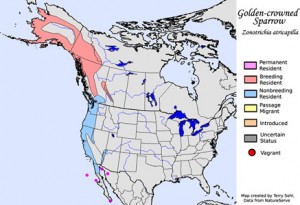
Breeding Grounds While nesting and raising young the Golden-crowned Sparrow stays at high latitudes throughout coastal Alaska and British Columbia (Heinl et al 2009).
Throughout the winter and migration Golden-Crowned Sparrows eat many different types of seeds including geranium, pigweed, starwort, dock, brome grass, sumac, nightshade, and knotweed. Fruit and Grain is also included in their diet ranging from apples, grapes, elderberry to oats, wheat, barley and corn. They will readily eat most brassicas out of your garden! Insects such as ants, wasps, bees, butterflies, moths, beetles, crane flies and termites are sometimes eaten, but mostly reserved for feeding nestlings. In the summer it is thought that their diet is made up of fresh green sprouts, fruits, spiders, and insects, but not much of this has been studied during this time of the year (BNA).
They tend to hop around on the ground and scratch out food from leaf litter, never straying very far from cover.
The Golden-crowns often form mixed flocks in the winter with Dark-eyed Juncos (Junco hyemalis) and closely related White-crowned Sparrows (Zonotrichia leucophrys). Although there is some competition for food resources among these species, they run at each other with raised crests, it seems to be limited by the Golden-crown’s preference for close cover and the Junco’s tendency to forage further from tree lines (Davis 1972). There have been some documented instances of hybrid White/Golden-crowned Sparrows, which is not surprising since they are very closely related with only an average of 4.1% nucleotide divergence (Zink et al, 1991) . Immature individuals of these two species are easily confused because of similar markings; the most reliable difference is the white supercillium and additional dark crown stripes of the White-crowns(Cornell).

Distinguishing crest features of Golden-crowned Sparrow v. close relative White-crowned Sparrow. -Joelle Montez
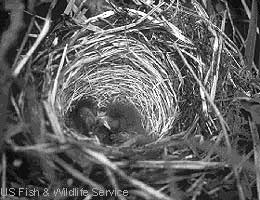
They are less aggressive in the summer but will defend breeding territories. They build nests on the ground and forage alone or with their mate to feed their young. They spend the majority of their time on the ground or on low branches making quick direct flights from one patch of shrubbery to the next (BNA).
During Fall of 2014 I observed Golden-crowned sparrows wintering in West Olympia. Despite them being considered common birds, I found them very difficult to find. Nearly all of my “sightings” were actually “hearings”. They have very distinct voices from other Emberizidae and I was able to get quite a few recordings of different vocalizations and songs. The Golden-crowned Sparrows seem to be very resilient birds, able to thrive in the tundra and urban cities.
Throughout my time observing the Golden-crowned Sparrows I created Scientific Illustrations and many visual notes.
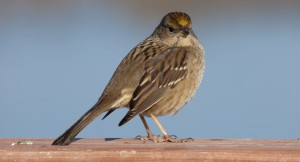
www.avianexplorer.com
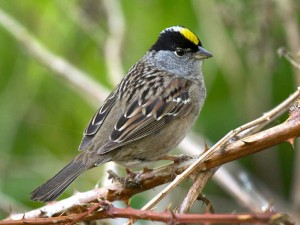
ebirdr.com
Burroughs, J., J. Muir, G. B. Grinnell, W. H. Dall, and C. Keeler. 1986.Alaska, the Harriman Expedition, 1899. Dover, New York.
Davis, John. Golden-crowned Sparrow. All About Birds. November 27th 2014.. “Habitat Preferences and Competition of Wintering Juncos and Golden-crowned Sparrows.” Ecology 54.1 (1972): 174-80. Print.
Heinl S, Piston A. 2009. Birds of Ketchikan Area, Southeast Alaska. Western Birds. 40(2):54-144. Cornell Lab of Ornithology.
King, J., & Farner, D. (1963). The Relationship of Fat Deposition to ~Zugunruhe~ and Migration. The Condor, 65(3), 200-223. Retrieved November 1, 2014, from http://www.jstor.org/stable/1365665
Longevity Records Of North American Birds (Current Through June 2014). (2001, March 1). Retrieved December 1, 2014, from http://www.pwrc.usgs.gov/
Norment, C. J., Hendricks, P., & Santonocito, R. (n.d.). Golden-crowned Sparrow (Zonotrichia atricapilla). Retrieved January 1, 2014, from http://bna.birds.cornell.edu/bna/species/352/articles/characteristics
Sibley, D. (2003). Emberizine. In The Sibley Field Guide to Birds of Western North America (1st ed., p. 429). New York: Andrew Stewart.
Zink, Robert M., Donna L. Dittmann, and William L. Rootes. “Mitochondrial DNA Variation and the Phylogeny of Zonotrichia.” The Auk 108.3 (1991): 578-84. Http://www.jstor.org/stable/4088098. Web. 17 Nov. 2014.

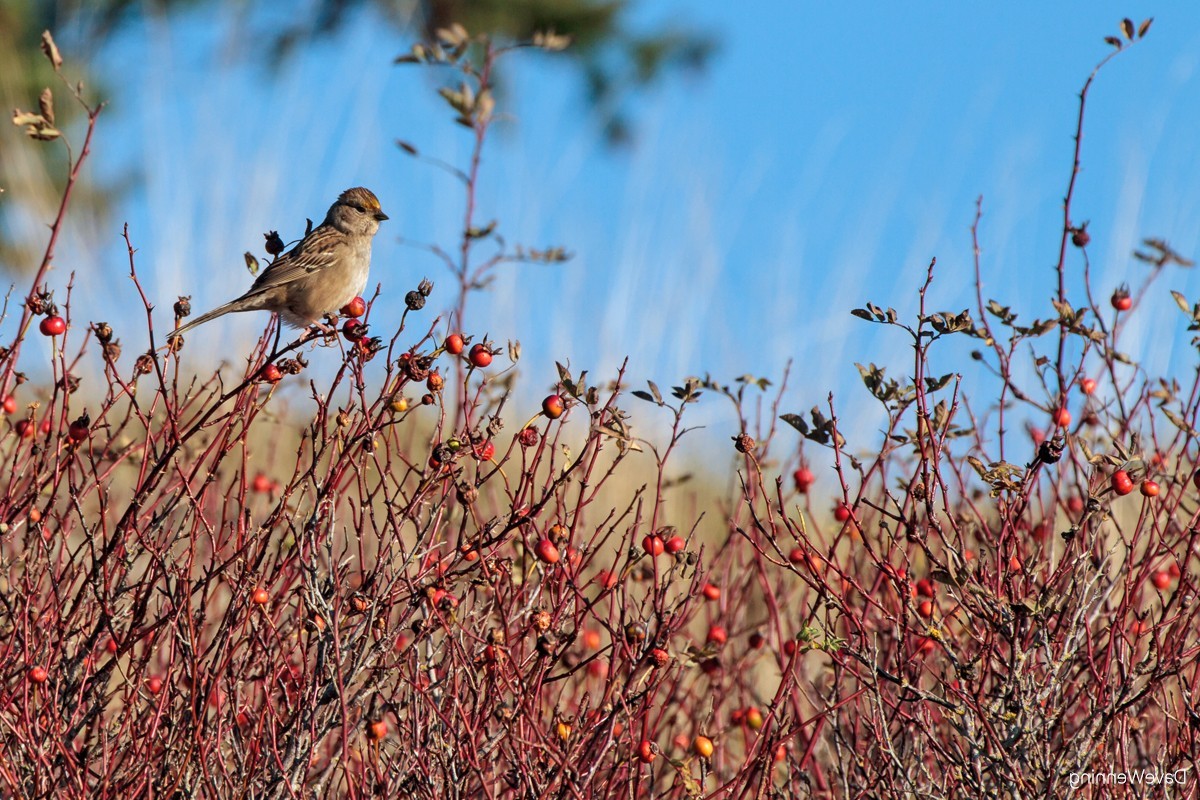
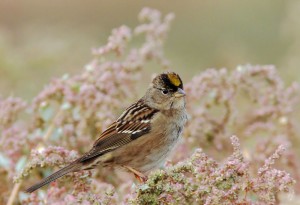
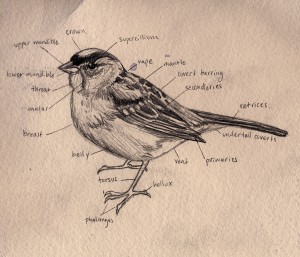
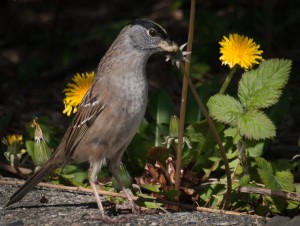
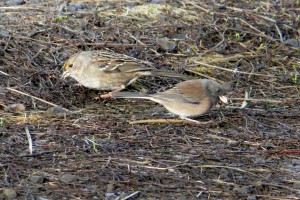
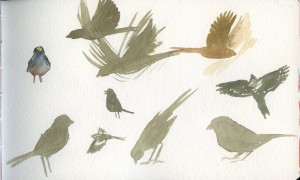
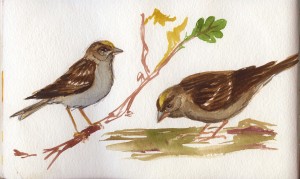
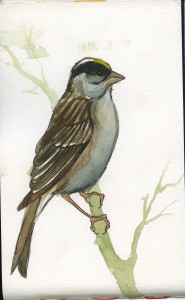
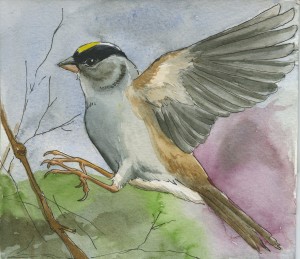
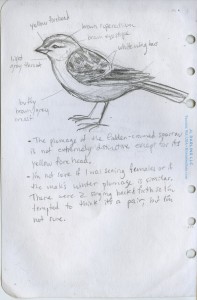
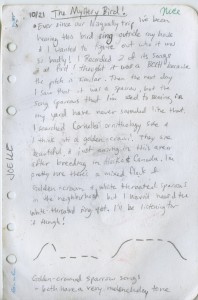
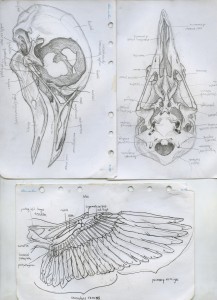
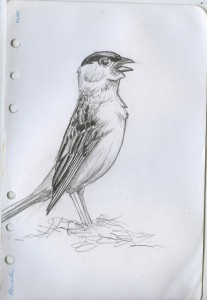
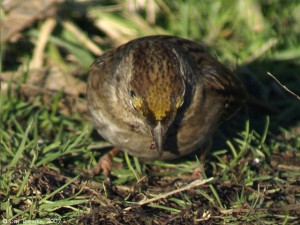
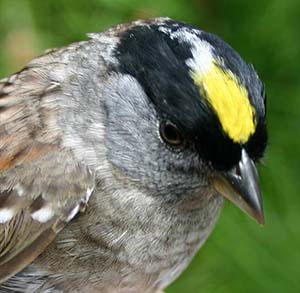
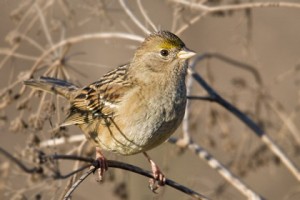
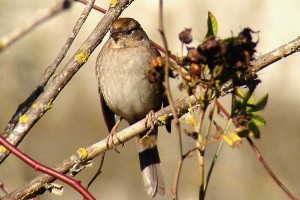
Leave a Reply